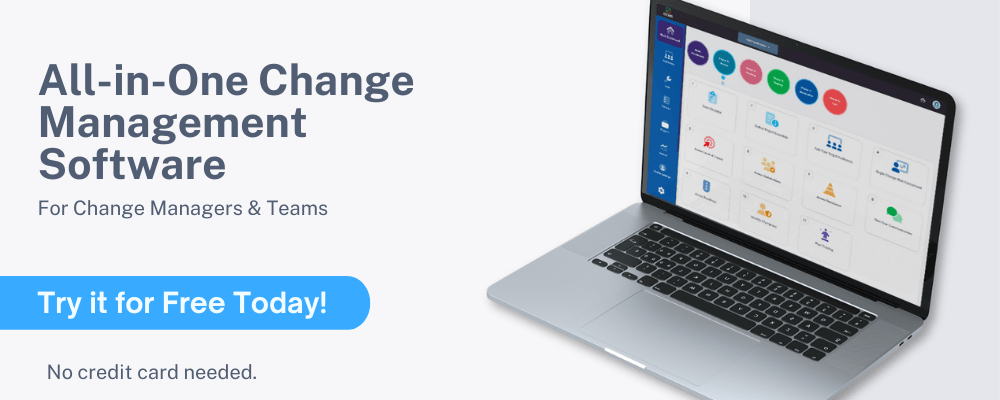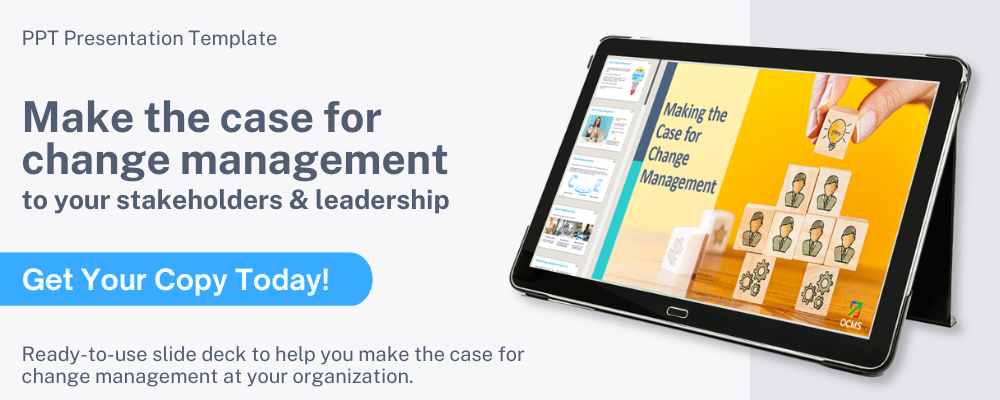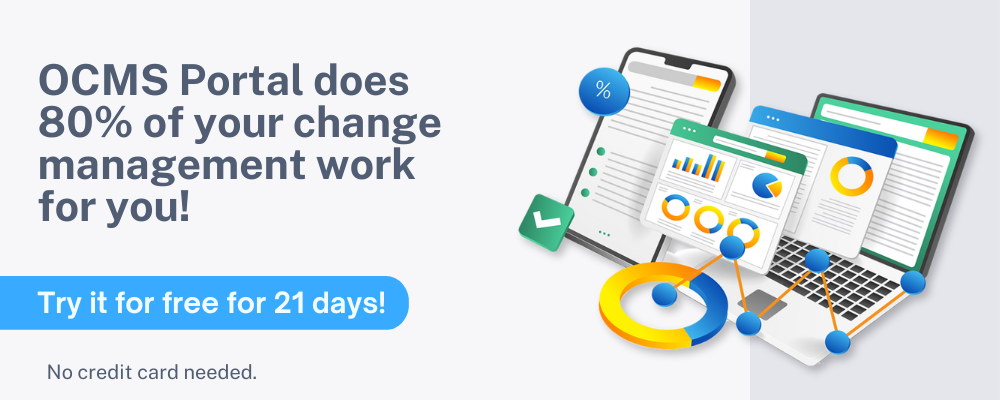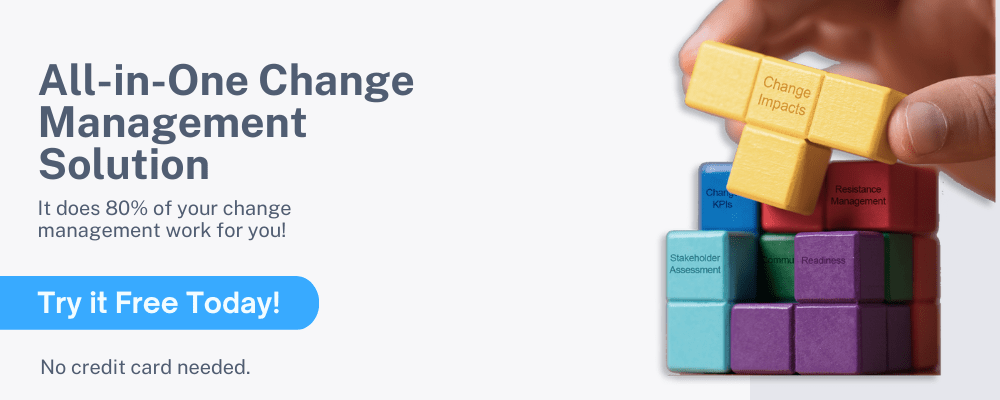How is the McKinsey 7S Model Used in Organizational Change Management? What are its Strengths and Weaknesses? Is it Still Needed?
 Unlocking Success with the McKinsey 7S Model: Your Friendly Guide to Organizational Brilliance
Unlocking Success with the McKinsey 7S Model: Your Friendly Guide to Organizational Brilliance
Welcome to the world of McKinsey’s 7S Model – a friendly guide to navigating the intricate landscape of organizational effectiveness. If you’ve found yourself on the quest for a tool that goes beyond the conventional, you’re in for a treat. The McKinsey 7S Model is not just a set of buzzwords but a dynamic framework that promises to unravel the mysteries of successful management and change.
Join us on this adventure as we unravel the mysteries of Shared Values, Skills, Staff, Strategy, Structure, Style, and Systems – the seven essential elements that can transform the way your organization operates.
No need to worry about complex jargon or confusing roadmaps; we’ll break it down in a friendly, approachable manner.
Let’s dive in and make the McKinsey 7S model work wonders for your unique journey!
Eager to explore what lies ahead? We’ve got you covered with our quick summary. Brace yourself for our deep dive into the McKinsey 7S Model Framework further down the page, and know that we’re here to accompany you on this exciting journey of exploration.
Quick Summary
Applying the McKinsey 7S Model for Effective Organizational Change
The McKinsey 7S Model is utilized in organizational change management to address a range of changes, from major shifts like introducing new departments or system integrations to smaller adjustments like refining business processes. The model, developed in the late 1970s, offers a holistic perspective on organizational dynamics, emphasizing the need for harmony among its elements for successful change management. Unlike providing a detailed roadmap, the model focuses on both “hard” and “soft” organizational aspects, recognizing their interdependence in driving and supporting change.
Large and small organizations have applied the McKinsey 7S model to understand various facets of their companies, particularly those not immediately apparent during change planning. The text anticipates and addresses common questions about the model’s suitability and effectiveness in diverse change management projects. Additionally, it clarifies that “7S model van McKinsey” refers to the Dutch term for the McKinsey 7S model.
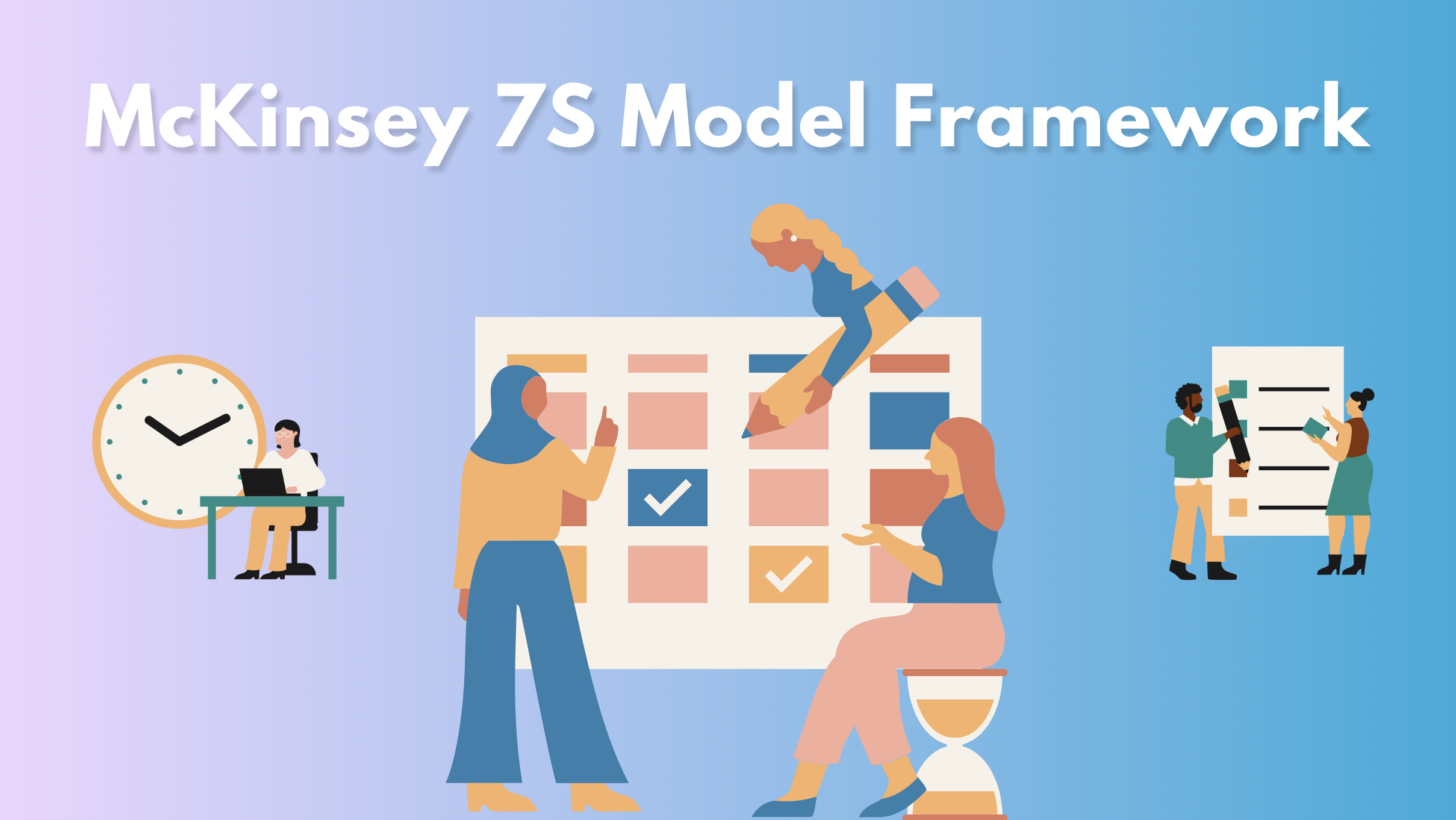
Cracking the Code: Understanding the Seven S’s in Management
The McKinsey 7S model for successful management consists of seven factors that are crucial for maintaining a balanced and competitive organization. Unlike other change management models, this framework doesn’t prioritize a roadmap or favor one factor over another. Instead, it emphasizes the coordination and balance of seven critical components:
- Shared Values (Soft)
- Skills (Soft)
- Staff (Soft)
- Strategy (Hard)
- Structure (Hard)
- Style (Soft)
- Systems (Hard)
These factors are alphabetized in the framework, with indication of whether they are considered “hard elements” (more easily defined and formalized) or “soft elements” (dealing with attitudes and work styles). The text also notes that searching for a specific sequence of these factors in terms like “7S model van McKinsey” or “McKinsey 7S model PPT” will not yield a predefined order.
The Core Seven: Exploring the Factors of the 7S Model
The McKinsey 7S Model comprises seven key factors crucial for business success, each playing a unique role in organizational effectiveness. The sequence of these elements is not predefined; however, all seven must be addressed to ensure organizational health and success. The factors are:
- Shared Values (Soft): Represents the company’s corporate culture, beliefs, mission, and reputation. It needs alignment with the other elements.
- Skills (Soft): Encompasses both organizational and individual employee skills. Ensures teams possess the necessary skills for competitiveness, and training is provided for change projects.
- Staff (Soft): Focuses on the balance and diversity of the workforce. Involves considerations such as hiring practices, turnover, and stakeholder analysis.
- Strategy (Hard): Describes the detailed plan or change management roadmap for moving from the current state to the desired future state. It needs alignment with the other six elements.
- Structure (Hard): Refers to the organizational structure or chain of command, determining authority relationships within the company.
- Style (Soft): Relates to managerial or departmental culture and openness to change. It can be challenging to address due to its personal nature.
- Systems (Hard): Encompasses physical systems, processes, and workflows. It involves understanding how work gets done within the organization and ensuring alignment with other factors for efficiency and productivity.
The McKinsey 7S Model is not a step-by-step guide but a holistic framework to assess and enhance various aspects of organizational dynamics. It is utilized for purposes such as boosting productivity, keeping change projects on track, identifying barriers, creating new strategies, aligning departments in mergers, implementing employee improvements, enhancing competitiveness, and uncovering opportunities.
Harnessing Harmony: A Practical Approach to the McKinsey 7S Model
To effectively use the McKinsey 7S Framework for a change management project, follow these steps:
- Impact Assessment: Evaluate how each of the seven factors in the McKinsey 7S model would be affected by the proposed change.
- Change Plan Creation: Develop a change plan that addresses the identified impacts, aiming to maintain balance among the seven factors.
- Ongoing Monitoring: Continuously check each of the seven factors throughout the change project to ensure they are gradually aligning and reaching a state of “post-change” harmony. Adjust the strategy as needed during this process.
- Post-Change Review: Once the change project is complete, review each factor in the McKinsey 7S example to verify that they are in balance.
The McKinsey 7S Framework can be challenging to navigate due to its non-prescriptive nature. To provide practical insights, various McKinsey 7S framework with company examples can be referenced to understand how other companies applied the model to their projects. This information, available in McKinsey 7S model PPTs and McKinsey strategy framework PDFs, can offer guidance on utilizing the framework effectively in the context of specific organizational changes or improvements.
Strategic Considerations: McKinsey 7S Model’s Pros and Cons Unveiled
Advantages of McKinsey 7S Model:
- Wide Applicability: The flexibility of the McKinsey 7S model allows it to be applied broadly, whether for navigating change or identifying weaknesses and opportunities within an organization.
- Holistic View: The model’s unique focus on harmony and balance provides a holistic perspective, helping companies uncover interconnected areas during change initiatives.
- Inclusion of People and Processes: Unlike some models that emphasize either people or processes, the McKinsey model incorporates both, ensuring attention to both human and technical aspects of change management.
Disadvantages of McKinsey 7S Model:
- Lack of Roadmap: One major drawback is the absence of a clear roadmap or specific steps for a change management program. The model is more of a general method to assess organizational balance.
- Tedious for Change Management: Applying the model to every step of a change management process across the seven elements can be time-consuming, especially for larger companies and projects.
- Better as a Gauge than a Strategy: While effective for assessing alignment before and after a change project, the McKinsey 7S model is considered more of a gauge than a detailed strategy. Other change management tools or models may be more suitable for planning and implementing change strategies.
Detailed Deep Dive
Some would argue that organizational change is happening on a continuous basis.
There are large changes, like the introduction of a new department, organizations moving to the cloud, system (ERP, CRM or HCM) integrations, and company expansions. As well as smaller changes, such as adding a job duty to your customer support team or improving business processes.
Companies have multiple moving parts that can be impacted by a change. Even the smallest change can set off a ripple throughout an organization. Understanding all the pieces of business that can be impacted by change is at the heart of the McKinsey 7S framework.
The 7S model McKinsey introduced back in the late 1970s takes a holistic look at what makes companies tick and how each element of a company needs to be in harmony for an organization to operate competitively and manage change successfully.
See Also: Bridges’ Transition Model for Change | All You Need to Know
This Article Provides an End-to-End View of All You Need to Know About McKinsey’s 7S Model
Key questions we’ll answer in this year’s objective overview of the McKinsey 7S framework include:
- What are the factors of the 7S model?
- Which of the following is the correct sequence of elements in McKinsey 7’S framework for business success?
- Is there a McKinsey 7S model PPT?
- Can I download a McKinsey 7S model PDF?
- Do you have a McKinsey 7S framework with company example?
- What are the ways a company can use the McKinsey 7S framework model?
- Can you list the McKinsey 7S model strengths and weaknesses?
What You’ll Accomplish
After reading this article, you’ll learn about McKinsey’s 7S framework in strategic management through a full McKinsey 7S analysis.
You’ll also find out how the 7S model McKinsey developed is used for organizational analysis and in change management projects.
Bonus: We have a downloadable McKinsey 7S framework PPT and McKinsey 7S framework PDF that you can use to explain this McKinsey change management method to others.

Analysis of McKinsey 7S Model Example
Quick Overview
Rather than get into a detailed roadmap, the McKinsey change management model focuses on both “hard” and “soft” organizational elements that need to be considered when driving change or as a basis for change.
The McKinsey 7S model example has been used by large and small organizations alike as a way to stay in touch with all aspects of their company, some of which may not be immediately apparent when planning a change project.
Is the McKinsey 7S example right for you? Is it going to be detailed enough to help with your change management project?
We’ve gone through the most frequently asked questions about the McKinsey 7S framework example and will be answering those here.
Note: Some people may search out “7S model van McKinsey.” This is not a person, rather the searches appear to be in Dutch, and “van” is simply Dutch for “of” or “from.”
Don’t Miss: John Kotter’s 8-Step Change Model | Pros & Cons
Do you have questions about the mckinsey 7 s model found in this article or the limitations of mckinsey 7s model? We’d love to hear from you, click here to contact us.
What are the Seven S’s for Successful Management?
The McKinsey 7S example of organizational management is designed quite differently than other change management models. It includes seven factors that need to be in balance for a healthy and competitive organization.
Rather than focusing on a roadmap to change or emphasize one factor over another, the McKinsey 7S example stresses that the coordination of these seven critical components of a company is what’s most important in a change strategy.
We’ll go into each factor in more detail shortly, but to get you started, here are the seven factors of the McKinsey 7S framework example:
- Shared Values (soft)
- Skills (soft)
- Staff (soft)
- Strategy (hard)
- Structure (hard)
- Style (soft)
- Systems (hard)
We’ve alphabetized the seven factors in the McKinsey 7S framework example above and also noted which are considered “hard elements” and which are considered “soft elements.”
Hard Elements are more easily defined and formalized, while Soft Elements can be more difficult to define since they deal with things like attitudes and work styles.
Now, if you search “7S model van McKinsey” or “McKinsey 7S model PPT” trying to find the right sequence for each of those seven factors, you won’t find one.
We’ll explain why in the next section.
Related: Kurt Lewin Change Model | Pros & Cons
Got questions on the disadvantages of mckinsey 7s model or the mckinsey 7s framework? Drop us a message and let us know.
What is 7S Methodology? Where Did it Come From?
Let’s start with where the McKinsey 7S framework came from, which will help reveal some of the philosophy behind it.
The McKinsey 7S framework model was introduced in the late 1970s by two former McKinsey consultants, Thomas J. Peters and Robert H. Waterman, who featured it in the book In Search of Excellence. McKinsey is a well-known business consulting firm.
After studying business strategy and success, Peters put forth the idea at the heart of the McKinsey 7S analysis, which was that companies were missing several key factors that helped their organizations run effectively because they were only focusing on strategy.
These factors, rather than having an order of importance, were all equally important. They were like the Knights of the Round Table, where each component is equally necessary.
You’ll often find people searching for McKinsey’s 7S framework PPT or McKinsey strategy framework PDF because Peters originally put forth his larger concept in a 700-slide, two-day presentation to a large corporation.
Of course, that long of a presentation wouldn’t work for all McKinsey clients, so the concept was condensed into the seven factors we find in McKinsey’s 7S framework in strategic management.
You can rest assured that our downloadable 7S McKinsey PPT and McKinsey 7S model PDF don’t have nearly as many slides as did Peters’ initial presentation.
How Do You Understand 7S Framework?
There are both advantages and disadvantages of McKinsey 7S model, which we’ll get into in more detail later in the article. But, one of the biggest issues people find with the 7S model McKinsey put out is that it’s hard to get your head around.
It doesn’t follow a clear path of “do this step, then do that step” like other change management models you find. One of the reasons is that the McKinsey change management model wasn’t specifically designed for change management, but more for business strategy in general.
The McKinsey 7S model example is more of a thermometer to take the temperature of your organization than a road map to follow for a change project.
If one of the seven factors of the McKinsey 7S example is out of balance, that indicates your organization isn’t healthy. Something needs to change.
To reiterate, the most important thing to remember about the McKinsey 7S framework example is that each of the seven factors is equally important.
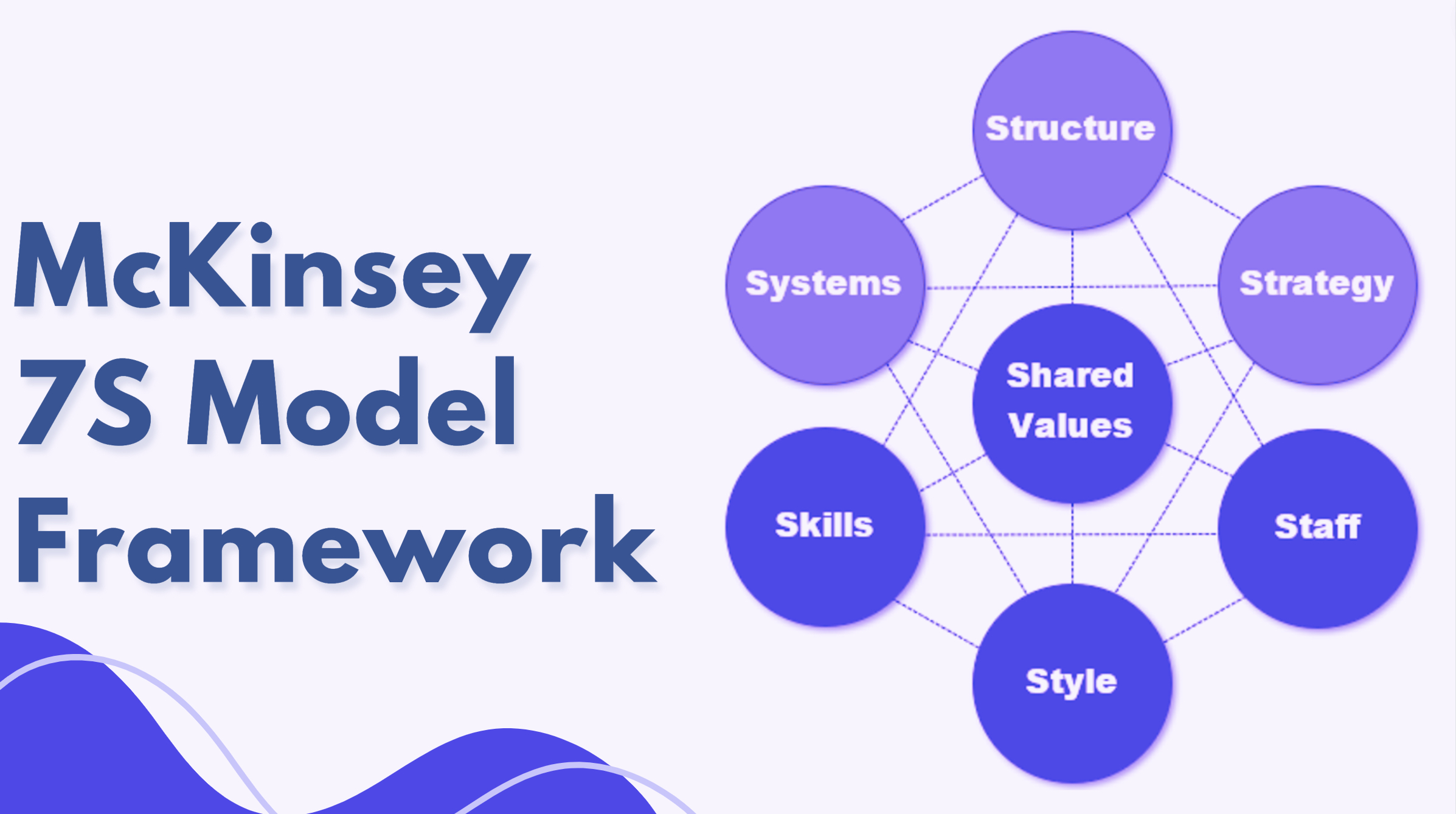
McKinsey 7S Framework Model
The easiest way to wrap your head around a McKinsey 7S framework with company example that you may be reading is to think of the seven factors as a circle or constellation rather than a ladder with steps.
What is the McKinsey 7S Model Used For?
A McKinsey 7S analysis can be done for a variety of reasons. It’s often mentioned for change management, and you may run across this when searching for a McKinsey 7S framework PPT or McKinsey 7S framework PDF.
However, because McKinsey’s framework in strategic management isn’t really a set of step-by-step instructions, but rather a general methodology for checking that a business is in balance, it can be used for different needs within an organization.
When looking at McKinsey 7S model strengths and weaknesses, one of the strengths is that it can be used in multiple ways.
Some of the ways that companies use the 7S model McKinsey developed are:
- Boost productivity and efficiency
- Keep a change project on track
- Identify areas in a business holding the company back
- Create a new business strategy
- Align departments during mergers or acquisitions
- Implement employee improvement strategies
- Determine how to become more competitive
- Uncover areas of opportunity
Popular Article: Prosci ADKAR Change Management Model – Still Relevant?
Are you looking for more information on mckinsey 7-s model with examples? Send us a message with your questions or comments.
What are the Seven Factors in the Seven S Model?
Now, let’s get a little deeper into what each of those seven factors in the McKinsey change management framework mean and how they apply to a business change strategy.
The information we’re providing below is also included in the downloadable 7S McKinsey PPT and McKinsey strategy framework PDF that you’ll find further down in this OCM Solution article.
First, let’s address one of the most common questions that people ask when reviewing the McKinsey 7S model example.
Which of the Following is the Correct Sequence of Elements in McKinsey 7’S Framework for Business Success?
If you’re used to using other change management models, you’ll most likely be looking for the sequence of which elements in the McKinsey 7S example to do first, second, etc.
There is no sequence. The McKinsey 7S framework example provides you with several factors that need to be in alignment for your organization to be healthy and thrive. However, there is no specific order to address each element; you simply need to make sure they’re all addressed at some point in your project.
- A Proven Change Approach to Managing Organizational Change
- Benefits of Organizational Change Management
- Change Management Success Factors
Shared Values
One of the factors in the McKinsey 7S framework is the shared values of the company. This is your corporate culture, belief system, and what you’re known for.
What does your company want to achieve? What’s its mission? Its reputation?
These are the kinds of questions that are answered in your shared values, and that need to be in alignment with the other 6 elements of the McKinsey 7S analysis.
If your company is known for being an innovator that blazes trails, do the processes you use also reflect that? If, for example, you are using antiquated systems to support your customer service activities, then your Systems factor would be out of balance with your Shared Values factor.
When it comes to applying McKinsey’s 7S framework in the strategic management of change, you want to ensure that your change project activities are reflecting your corporate culture and shared values.
Skills
This area of the 7S model McKinsey developed includes both organizational skills and individual employee skills.
You want to ensure that your team has the skills necessary to keep you competitive. And in the case of a change project, provide proper employee training to give your team the skills needed for the new process.
Another part of this factor in the McKinsey change management framework is to decide which skills should be kept in house and which ones would be more efficient as outsourced skills.
Staff
Your staff is another important element in the McKinsey 7S model example. You have to ensure your staff is balanced and diverse, so you’ll have economies of scope.
Other important considerations when thinking of staff are your hiring practices, turnover, and staff policies that can help or hurt your business. Doing a stakeholder analysis at the start of a change project can help you understand where everyone stands.
As an example, if you’re a U.S. company developing a change project that involves expanding your operations to Singapore, the following would be staff imbalances with other areas of your business (systems, processes, skills) that you would need to address:
- If your hiring practices didn’t include Singapore related job posting sites
- If you did not have anyone on your team that was familiar with the country
- If your phone systems did not include local Singapore phone numbers
Strategy
If you’re searching online for McKinsey’s 7S framework PPT or a McKinsey 7S model PDF, you might run across certain sites saying that “strategy” is the most important of the 7 S’s. However, in reviewing the McKinsey 7S example on McKinsey’s website, they’re clear that all seven elements are equally important.
McKinsey describes strategy and organization as “two sides of the same coin.” Your strategy is how you plan to move your company toward its goals, while also remaining adaptive.
When it comes to a change project, the strategy element in the McKinsey 7S example would be the detailed plan or change management roadmap you follow to get from your current state to your desired future state.
This roadmap strategy needs to be in alignment with all the other 6 factors within the McKinsey 7S framework.
Structure
The structure element in the McKinsey 7S framework example refers to your classic organizational structure or chain of command. These are also known as authority relationships.
Who needs to sign off on a change communication? Who should you alert if your timeline is changing? If your organization’s structure is complex, the answer to those questions might not be clear to employees managing a change.

McKinsey 7S Example of Change Management
Style
Style is related to culture but is more about a personal managerial style or the culture a certain department might operate under. For example, some departments may be more open to outside ideas than others.
Style is one of the more difficult areas of the McKinsey 7S analysis to get on top of, because it’s very personal, and changing people’s managerial styles requires helping them become more self-aware.
This is where you will run into: “But that’s the way we do it around here” and similar types of attitudes that are resistant to change, so it’s a vital part of the McKinsey 7S framework model to address.
Having a resistance management strategy can help bring this factor into balance with others.
Systems
Systems refer both to the physical systems your team works with and the processes and workflows you have in place. What happens within your IT infrastructure after an order is placed at your company or how your HR department handles time-off requests are both systems.
You can think of the systems element of McKinsey’s 7S framework in strategic management as “how work gets done.”
When planning a change, you’ll want to ensure systems, including technology and processes, are aligned with the other six factors to drive efficiency and productivity.
What is the Most Important S in the 7S Model?
If you’re searching on “7S model van McKinsey” in Dutch, “McKinsey 7S framework PDF” or any similar search term, you’ll see that all seven elements in the 7S Model McKinsey developed are treated equally.
The main point of the McKinsey change management framework using 7S is that these are seven equally important elements of your organization. And that they need to be working together in harmony.
How Do I Use McKinsey 7S Framework?
When you’re considering the advantages and disadvantages of McKinsey 7S model, you’re likely to wonder, “How do I use it?”
There are seven elements that are pretty straight forward, but what do you do with them to drive an organizational change project?
You’ll find some helpful suggestions in our McKinsey 7S model PPT and McKinsey strategy framework PDF, and we’ll go through a series of steps below that you could use.
Steps for Using the 7S model McKinsey developed for a change management project:
- Do an impact assessment to see how each of the seven factors in the McKinsey 7S model example would be impacted by the change.
- Create your change plan to address those impacts and with a goal to maintain balance.
- Throughout your change project, check each of the seven factors to ensure each is being brought into a “post change” harmony, adjust strategy as needed.
- Once your change project is complete, review each of the McKinsey 7S example factors to ensure they’re in balance.
McKinsey 7S Framework with Company Example
Because of the nebulous nature of the McKinsey 7S framework example, it can be difficult to know where to start or how to use this model in a sequence needed for change management or company improvement.
We’ve found a few different links to McKinsey 7S framework with company example to help you with references of how other companies applied this model to their projects.
- McKinsey 7S framework model with Coca-Cola
- Ithaca Beer Company McKinsey 7S model PDF
- Starbucks McKinsey change management example
How Do I Apply the McKinsey 7S Model Example to My Change Project?
Here is a brief example of how to use the McKinsey 7S framework model to keep your company in balance during a change project.
Project: Moving from a fully onsite staff to 50% remote working staff
| McKinsey 7S Factor | Current State | Desired Future State | Need to Do This to Get There or Maintain Balance |
| Shared Values | Sustainability Team oriented Customer-Centric | Sustainability Team oriented Customer-Centric | Foster team connection using cloud Ensure phone system is cloud-based |
| Skills | Proficient at current applications | Add proficiency in remote cloud programs Add new skills for remote working protocols | Establish training plan and evaluation method for new skills needed for remote workers |
| Staff | No one has worked remotely before | Have staff member with experience managing remote teams | Hire appropriate candidate with remote supervisory experience |
| Strategy | Current strategy is to serve customers as we have for 40+ years | Strategy that involves serving customers “anywhere, anyplace” | Develop a plan that includes marketing and processes to enable expansion of strategy to include remote teams. |
| Structure | Structure includes clear chain of command for onsite employees | Structure to be just as clear, but include chain of command for both remote and onsite employees | Review leadership/managers and come up with structure changes needed. |
| Style | Managers are used to having teams in the same building. | Managers treating onsite and remote employees the same as far as job duties, importance, promotions, etc. | Leadership training needed to indoctrinate managers and systems to support real-time communication for remote teams. |
| Systems | Workflows don’t currently involve remote employees, but are cloud-based; Technology supports remote teams. | Technology and workflows can be used seamlessly by onsite and remote teams. | Update any workflows needed and get feedback on processes to ensure they’re sufficient to support remote teams. |
Advantages and Disadvantages of McKinsey 7S Model
Now, let’s take a look at the McKinsey 7S model strengths and weaknesses. Not all companies are going to find the 7S model McKinsey put together to be easy to follow or implement.
Here are the main advantages and disadvantages of McKinsey’s 7S model.
McKinsey Change Management Model Advantages:
- It Can Be Applied Widely: The flexibility of the 7S model McKinsey promotes is one of its biggest strengths. It can be applied whether you’re going through change or to help identify weaknesses and opportunities in your organization.
- It Takes a Holistic View: The framework by McKinsey is unique in that it focuses on harmony and balance within your organization. It helps companies to identify areas they may not see as connected and view them holistically when it comes to change.
- People & Processes are Included: Some change management models focus heavily on people, and others focus more on processes. The McKinsey change management model includes both, ensuring both the human and technical elements of change management are kept in focus.
McKinsey Change Management Model Disadvantages:
- There is No Roadmap to Follow: A big drawback with the McKinsey 7S model example is that it does not give you steps or any roadmap to follow for a change management program. It’s more of a general method to ensure your organizational elements are in balance.
- It Can Be Tedious for Change Management: If you have to check every step of your change management process across each of the 7 S’s in the McKinsey 7S model, you would hardly have time to do anything else. Unless you have a small company and project, it can be tedious to use for change management planning.
- It’s Better as a Gauge Than a Strategy: The McKinsey 7S example is better when used as a gauge at the beginning and end of a change management project to ensure alignment of the 7S areas of your organization. Using a different change management tool or model makes more sense for your actual change strategy and planning.
PowerPoint & PDF Downloads | What are the Components of the 7S Framework?
Are you looking for a McKinsey 7S framework PPT that provides a comprehensive overview of the components in the 7S model in an easy-to-read format?
We’ve put together a free downloadable 7S McKinsey PPT and exported that to a downloadable McKinsey 7S framework PDF. You can access both of these below.
Our McKinsey’s 7S framework PPT and McKinsey strategy framework PDF include a shortened version of the information in this article. We’ve also included several helpful visuals in the McKinsey 7S model PPT and PDF.
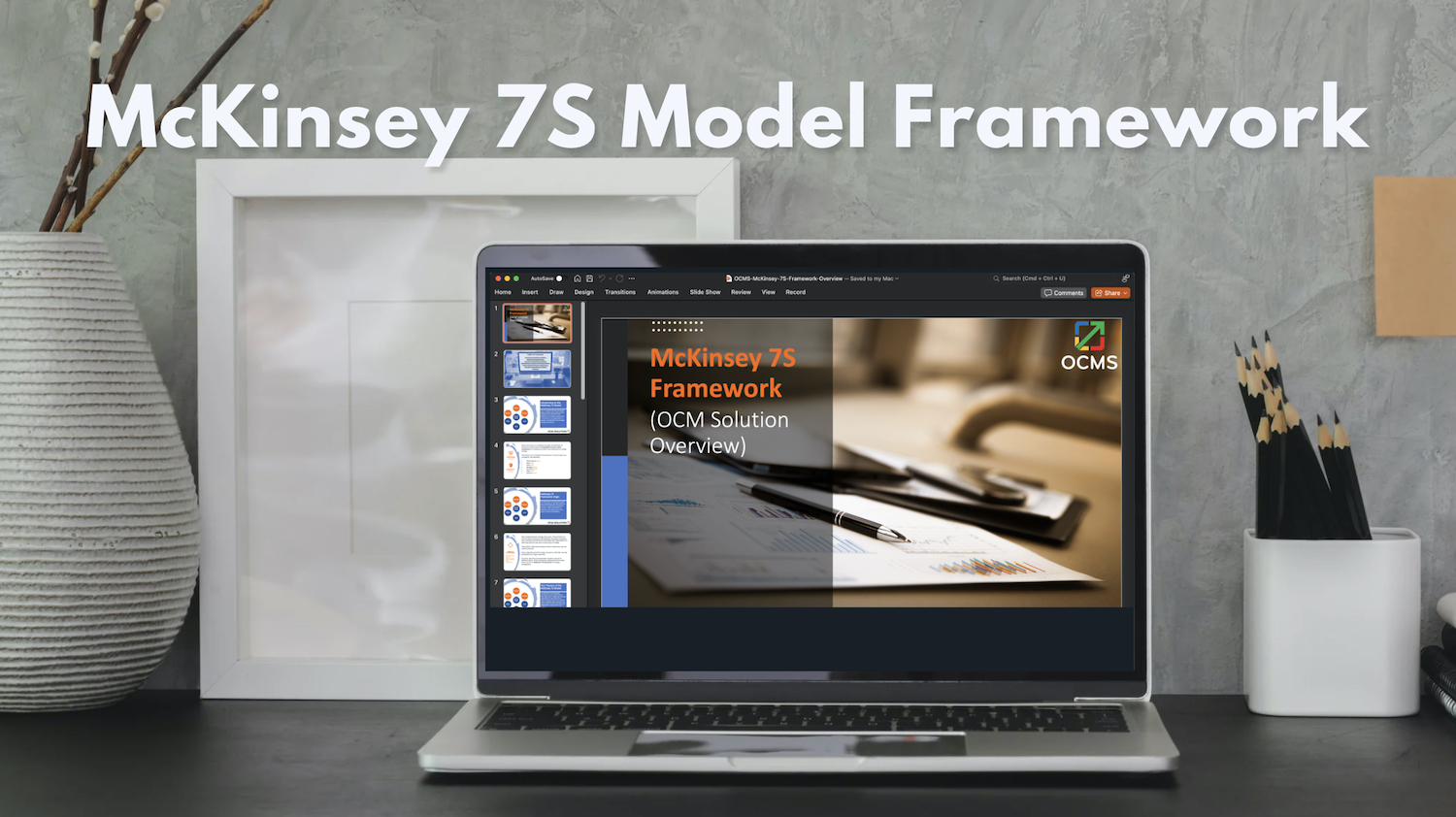
► Get Your Free OCM Account and Access Free McKinsey 7S Framework Resource
Conclusion – Review: Everything You Need to Know About McKinsey 7S Model
The McKinsey 7S model example is a powerful tool to look in-depth at your organization and identify areas where it may not be operating in harmony. It offers a unique insight into seven key areas that other change models don’t explore in the same way.
The biggest problem with using the 7S model McKinsey developed is that it’s not well suited as a step-by-step strategy for change management. It’s much better when used as a thermometer to “check the temperature” of your company and see where things may be problematic and to identify areas that need change.
The McKinsey 7S example can be helpful at the start and finish of a change project as a gauge to keep those seven elements of your organization in balance after a change project occurs. In this way, it’s flexible to use alongside another change management model.
Even if you don’t use the McKinsey change management framework for your change projects, it’s still a very helpful framework to learn and can give you deeper insight into the different moving parts of your organization.
CHANGE MANAGEMENT ASSESSMENTS
- Stakeholder Analysis
- Change Impact Assessments
- Organizational Readiness Assessment
- Program Assessment
Read More: Is Prosci Change Management Needed? All You Need to Know
Note: Content on OCM Solution's ocmsolution.com website is protected by copyright. Should you have any questions or comments regarding this OCM Solution page, please reach out to Ogbe Airiodion (Change Management Lead) or the OCM Solution Team today. OCM Solution was previously known as Airiodion Global Services (AGS).
Images: https://stock.adobe.com/, https://unsplash.com/photos/jxUuXxUFfp4


